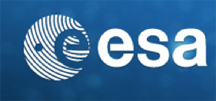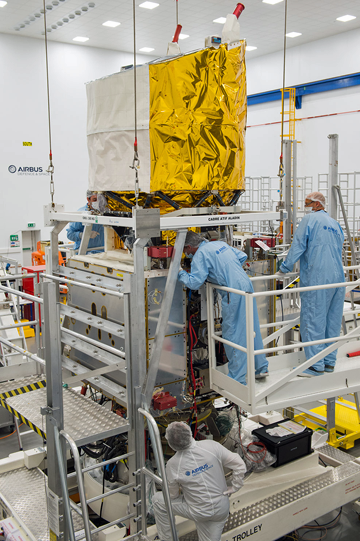

Aeolus, the European Space Agency’s wind sensing satellite, is leaving Stevenage, UK, sometime in the next few days on the first leg of its journey to space—the spacecraft will be shipped to Toulouse, France, for final testing before traveling to French Guiana toward the end of the year ready for an Arianespace launch on a Vega launcher.

ESA's Aeolus during the build process in the UK.
The 1.7 ton spacecraft, primed by Airbus Defence and Space, features the LIDAR (Light Detection And Ranging) instrument called Aladin, which uses the Doppler effect to determine the wind speed at varying altitudes. Aladin fires a powerful ultraviolet laser pulse down through the atmosphere and collects backscattered light, using a large 1.5 meter diameter telescope, which is then analyzed on-board by highly sensitive receivers to determine the Doppler shift of the signal from layers at different heights in the atmosphere. The data from Aeolus will provide reliable wind-profile data on a global scale and is needed by meteorologists to further improve the accuracy of weather forecasts. Aeolus will fly in a 320 km orbit and have a lifetime of three years.
The spacecraft is leaving Stevenage on 29th January and will make its way by road to Toulouse (Intespace) in a special convoy. Testing will involve simulation of the Vega launch environment using special vibration and acoustic facilities. Following this the spacecraft will move on to specialist facilities at CSL in Liege, Belgium where it will undergo thermal vacuum tests to simulate the extremes of the space environment together with full performance testing of the instrument system.
Andy Stroomer, the Head of Earth Observation, Navigation and Science in the UK for Airbus, indicated that with the shipment of Aeolus, the company reached a key project milestone and is now looking forward to launching Aeolus as the forerunner of an operational system that will contribute significantly to improving weather forecasting.
Beth Greenaway, the Head of Earth Observation at the UK Space Agency, added that it is great to see the Aeolus nearing completion. This is a tangible result of the UK contribution to the ESA EO Envelope program over many years and is the latest in the Earth Explorer series. These observations will advance understanding of tropical dynamics and processes relevant to climate variability. Accurate wind forecasts are also vital for commercial undertakings such as farming, fishing, construction and transport. Following the successful ESA Ministerial in December, where the UK allocated more than 1.4 billion euros over the next five years to European Space Agency programs, the agency is looking at taking leading science and industrial roles in many future missions, as well.

